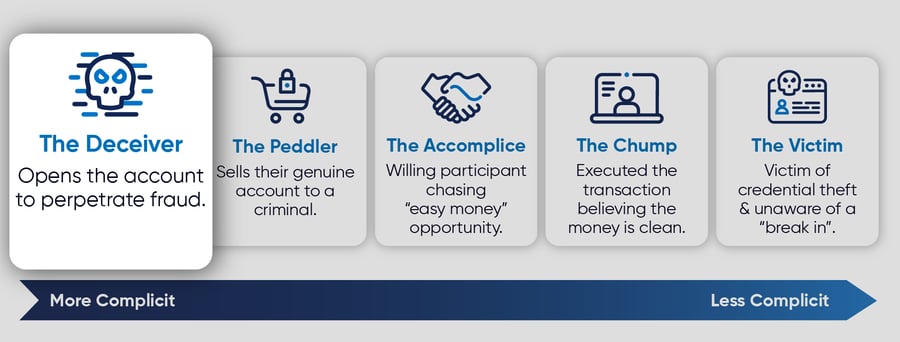In our last blog, Money Mules and the Shopping Cart Theory, we spent time learning about what money mules are, how they impact financial institutions, and what makes them tick while drawing parallels to the popular shopping cart theory to determine why mules do what they do. As a quick recap, a money mule is someone who illegally transfers or moves money on behalf of someone else. This is problematic for financial institutions as more and more consumers utilize online banking to move funds.
Unlike other forms of fraud, there are many different and unique cases associated with money mules. BioCatch has created a set of personas that helps to define these use cases to better understand the different combination of actions taken from cybercriminals and genuine users.
The first persona we are delving into in the series is The Deceiver. To help convey the clear intent of this persona, I tried to think of a situation where I (“cough cough”), I mean someone I knew, directly deceived someone. When my friend was younger, he would often skate to school instead of riding the bus. He always said that one of these days, he would go to the skatepark instead of class. It was a perfect Friday morning when he finally decided to skip. Unfortunately, when Monday came around, he had to bring in a sick note signed by a parent, or he would be truant. That’s when I, I mean he, decided to write the sick note in his father’s handwriting and sign it as him. In this scenario, my friend directly deceived his dad as well as the school. If only the school had the right tools and resources to identify the falsified paperwork and catch the deceiver in action.

In the world of mule accounts, the Deceiver resides on the darkest portion of the complicit scale meaning this persona has the highest level of criminal intent when opening an account. They either open the account with false paperwork or often with a stolen or synthetic identity. Their actions can range from opening a single account with a single transaction to a full-blown money laundering operation. The Deceiver can directly impact both financial institutions as well as the everyday consumer. The Deceiver will often directly open accounts to perpetrate fraud, but they will also target genuine users to function as mules within the operation.
The FBI Internet Crime Complaint Center recently reported an uptick in scams designed to trick consumers into mule operations. According to the FBI, “The increases in these scams could be the result of isolation due to COVID-19 quarantine restrictions, the loss of employment due the COVID-19, and increases in remote work which allowed criminals to instruct money mules to provide copies of their personal information online.”
There is a strong desire among financial institutions to do more about it. Research by Aite-Novarica on the topic shows more than 80% of fraud executives believe that more can and should be done to mitigate mule activity at their institution. Technologies such as behavioral biometrics are playing a critical role in helping them achieve this.
Learn how financial institutions are mobilizing to address the problem of money laundering and mule accounts in the Aite-Novarica report, The Emerging Case for Proactive Mule Detection.



